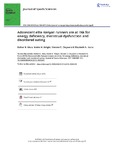| dc.description.abstract | Limited data are available on the female athlete triad (Triad) in athletes from minority groups. We explored subclinical and
clinical Triad components amongst adolescent elite Kenyan athletes (n= 61) and non-athletes (
n= 49). Participants completed demographic, health, sport and menstrual history questionnaires as well as a 5-day weighed dietary record and exercise log to calculate energy availability (EA). Ultrasound assessed calcaneus bone mineral density (BMD). Eating
Disorder Inventory subscales and the Three-Factor Eating Questionnaire’s cognitive dietary restraint subscale measured
disordered eating (DE). EA was lower in athletes than non-athletes (36.5 ± 4.5 vs. 39.5 ± 5.7 kcal∙kg FFM−1
∙d−1,P= 0.003). More athletes were identified with clinical low EA (17.9% vs. 2.2%, OR = 9.5, 95% CI 1.17–
77,P= 0.021) and clinical menstrual dysfunction (32.7% vs. 18.3%,χ2= 7.1,P= 0.02). Subclinical (75.4% vs. 71.4%) and clinical DE(4.9%vs. 10.2%,P= 0.56) as well as BMD were similar between athletes and non-athletes. More athletes had two Triad components than non-athletes (8.9% vs. 0%, OR = 0.6, 95% CI 0.5–6.9,P= 0.05). Kenyan adolescent participants
presented with one or more subclinical and/or clinical Triad component. It is essential that athletes and their entourage be educated on their energy needs including health and performance consequences of an energy deficiency. | en_US |

